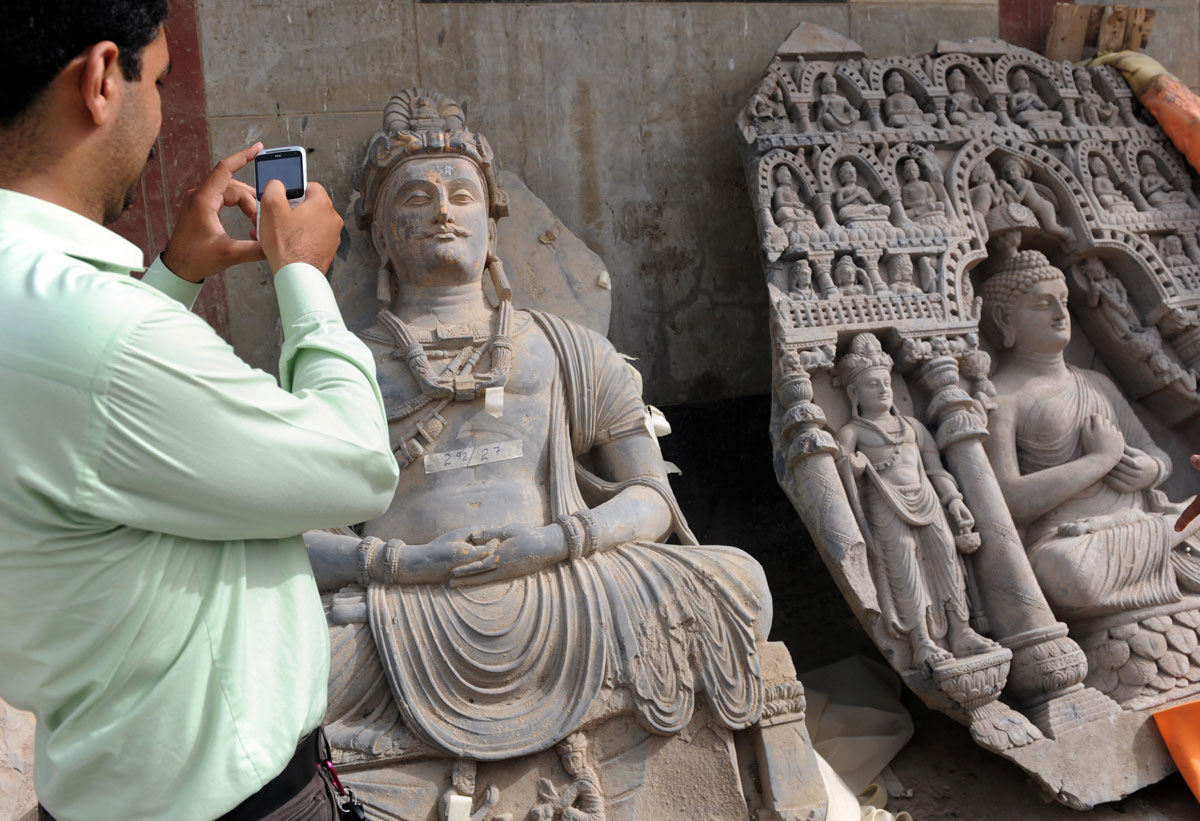Pakistan can Attract Pilgrims from Buddhist Nations: Imran Khan
This picture taken on August 7, 2012 shows a visitor as he takes photographs on his mobile, of seized ancient statues at a museum in Karachi. Pakistan is home to two ancient civilizations, the Indus, which dates back to between 2500 and 1700 BC, and the Gandhara, from 530 BC to 1021 AD. It is the Gandhara artefacts that are most highly prized – statues of the Buddha, Siddhartha Gautama, who was born in Nepal in the 6th century BC and whose teachings grew into a major religion, can fetch thousands of dollars across the world. (Rizwan Tabassum/AFP/GettyImages)
Cricketer-turned-politician Imran Khan said, Nov. 15, Pakistan can attract pilgrims from Buddhist nations as he stressed on the need to secure and maintain the archaeological sites related to Buddha in the Muslim country.
The Pakistan Tehrik-e-Insaf chief made the remarks during his visit to the archaeological sites at Bhamala Khanpur of Hariput district in the Khyber-Pakhtunkhwa along with the defense attaché of Sri Lanka and a South Korean diplomat.
“We can attract Buddhists from Japan, Thailand, Malaysia, Sri Lanka and many other countries for their sacred places,” said Khan, whose party is ruling the province.
Khan said that by securing and maintaining the remains and archaeological sites the government would reestablish this sector, according to Khyber-Pakhtunkhwa Chief Secretary Azam Khan.
“We have also started anti-encroachment drive in all archaeological sites particularly at Bannu, Peshawar, Mardan and Sawabi,” he said.
Two rare and ancient Buddha statues have been unearthed at the Bhamala site. The largest ever statue found at the site depicts the death of Buddha and a second statue is a Buddha with a double halo.
The statue depicting the death scenario was the oldest of its kind in the world. It was also verified by the American laboratory which identified it as older than third century BC.

The Khyber-Pakhtunkhwa government, with the cooperation of Hazara University Archaeology Department, and Wisconsin University in U.S., started excavation during 2015-16 and they discovered 14-meter high sculpture of Buddha and many other rare objects from the site.
During the excavation, archaeologists also discovered some other important objects including sculptures made of clay and percolate, coins made in silver, copper and iron tools.
The diplomats lauded the efforts made by the Archaeology department of Khyber-Pakhtunkhwa which has carried out excavation and discovered historic artifacts of Buddha and remains of the ancient architecture.
The discoveries included a 48-feet long part of sleeping Buddha the longest one among those existed in different parts of the world.
Sri Lankan Defense Attaché Brig. Hemant Bandara and senior south Korean diplomat Kim Ing Ko thanked the provincial government for inviting them and providing an opportunity to see centuries old artifacts of Buddha.
Briefing visitors, Research Officer of Peshawar Museum Nawaz ud Din said Bhamala area is a part of Taxila Civilization and it remained one of the central places of worship for the followers of Buddhism.
The UNICEF had declared this area as World Heritage site.


